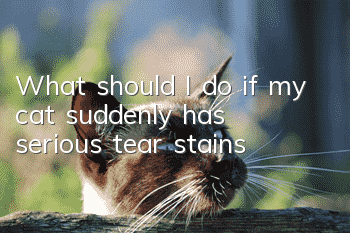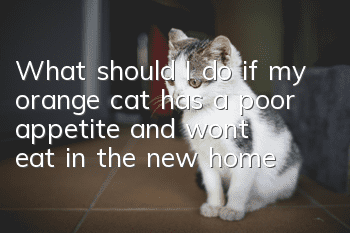What should I do if my cat suddenly has serious tear stains?

Solutions to heavy cat tear stains:
1. Wipe with hot towel. This method is the simplest and most effective method. If the cat’s tear stains appear for a short time, then Just wipe it with a hot towel every day and it can be eliminated in time.
2. If the cat’s tear stains are stubborn and cannot be solved by simply erasing them, you can mix starch and boric acid powder, mix the powder into a paste with warm water, and then add the paste Apply the paste on the cat's tear stains, wait for the paste to dry naturally, and then it will fall off naturally. Then wipe it clean with a towel to remove the cat's tear stains.
3. If you want to eliminate your cat’s tear stains, you can also feed it some fresh fruits and vegetables in an appropriate amount. For example, apples and pears are rich in vitamins and water, which can supplement the cat’s certain nutrients and manage the tear stains. In addition, Cats eating purple sweet potatoes also have a certain effect on improving tear stains.
4. If the tear stains last for a long time and do not improve, you need to go to the pet hospital for examination in time.
Causes with heavy tear marks:
1. If the cat’s eyelashes are not trimmed regularly, the cat’s eyelashes will grow too long, and the eyelashes will grow upside down. It will stick to the inside of the cat's eyeballs, irritating the eyes, causing the eyes to always be wet, and tear stains will form.
2. Cat’s eyes are relatively sensitive parts. When a cat’s eyes are infected by bacteria, dust irritation, irritation of its own eye hairs, and eye inflammation, it will cause continuous tear stains and severe tearing.
3. Severe tear stains in cats are likely to be caused by eye diseases, such as conjunctivitis, keratitis, epiphora, etc. Generally, in addition to excessive eye discharge, moist eyes, heavy tear stains, etc., there will also be symptoms of redness and swelling.
4. Feline rhinotracheitis is an acute infectious disease with strong upper respiratory tract infection in cats, also known as infectious rhinotracheitis. The causative agent of feline rhinotracheitis herpesvirus is feline rhinotracheitis herpes virus. Once a cat is infected, symptoms such as increased eye discharge and sneezing will occur.
- Why does the kitten keep sneezing?
- How do cats communicate with each other?
- Cat vomited a puddle of yellow water after eating cat grass
- Nutritional needs of healthy cats
- Two ways to measure the temperature of pet cats
- Why does the cat meow when the owner takes a bath?
- Can cats eat chicken liver?
- Why can’t Cat Howl Spring be interrupted?
- Will the color of lanugo change after gold gradient layer change?
- Will Ragdoll cats be lonely at home alone?



